Effect of Cereclor as Rejuvenator to Enhance the Aging Resistance of Reclaimed Asphalt Pavement Binder
Abstract
:1. Introduction
2. Objectives of the Research
- To characterize the colloidal instability of Virgin Binder pen grade 60/70 (VB), RAP binder, and Rejuvenated RAP binder after applying the artificial aging through fractional composition.
- To depict the effect of rejuvenation on the aging resistance of Virgin, RAP binder, and Rejuvenated RAP binder after applying the artificial aging.
- To investigate the effect of rejuvenation on rheological characteristics of Virgin, RAP binder and Rejuvenated RAP binder after applying the artificial aging.
- To establish correlations between the physical, rheological, and chemical parameters of Virgin, RAP binder, and Rejuvenated RAP binder after applying the artificial aging.
3. Materials and Methods
3.1. Materials
3.2. Rejuvenation
3.3. Testing Methods
4. Results and Discussion
4.1. Conventional Properties of the Virgin, Aged, and Rejuvenated Aged Binders
4.2. Chemical Composition of Virgin, Aged, and Rejuvenated Aged Binders by SARA Fractionation
4.3. Flow Characterization of Virgin, Aged, and Rejuvenated Aged Binders
4.4. Fourier-Transform Infrared Spectroscopy (FTIR) of Virgin, Aged, and Rejuvenated Aged Binders
4.5. Rheological Characterization of Virgin, Aged, and Rejuvenated Aged Binders
4.6. Correlations between Physical, Rheological, and Chemical Parameters of Asphalt Binder
5. Conclusions
- The SARA test results showed significant changes in the colloidal structure of aged and rejuvenated aged binder mixes. In the virgin binder, artificial aging increased the asphaltene contents and reduced the aromatics. However, this trend was more significant in the RAP binder due to the drastic effect of aging. The rejuvenator substantially restored its colloidal structure due to the change in asphaltene and maltene contents, as well as varying the locations of constituents and the more stable structure, even after applying artificial aging.
- During the aging of asphalt binder, the oxidation of methylene and degradation of unsaturated chains and naphthenic rings of benzene molecules promoted the production of ketone and carboxylic acid groups, which ultimately increased the carbonyls and sulfoxide that contribute to higher stiffness and low-temperature cracking. The addition of Cereclor reduced the carbonyls and sulfoxides of the aged binder, enhanced its resistance to aging, and would contribute to the long-term performance.
- From DSR test results, it has been observed that the rejuvenator shifted PG grades in both the upper and lower temperatures, i.e., from ’82-4’ to ’64-16,’ confirming the significant rejuvenation effect on the aged binder. Furthermore, increasing the low-temperature grades had a significant effect on the resistance to initiation or development of low-temperature cracking and permanent deformation at higher temperatures. This observation also suggests that if only performance grade is considered, the dosage amount of the rejuvenator can be varied to measure the rejuvenating effect at a wide range of temperatures to meet the binder specification.
- It can be concluded that relatively good correlations exist between physical, chemical, and rheological properties of asphalt binder, and more accurate correlations can be established with more data and a list of experiments. Such correlations may be useful to explore the quick and unknown parameters of asphalt binders.
Author Contributions
Funding
Acknowledgments
Conflicts of Interest
References
- Kennedy, T.W.; Tam, W.O.; Solaimanian, M. Effect of Reclaimed Asphalt Pavement on Binder Properties Using the Superpave System; University of Texas at Austin: Austin, TX, USA, 1998; p. 1250. [Google Scholar]
- Al-Qadi, I.L.; Aurangzeb, Q.; Carpenter, S.H.; Pine, W.J.; Trepanier, J. Impact of High RAP Contents on Structural and Performance Properties of Asphalt Mixtures; Illinois Center for Transportation: Rantoul, IL, USA, 2012; pp. 0197–9191. [Google Scholar]
- Hafeez, I.; Ozer, H.; Al-Qadi, I.L. Performance characterization of hot in-place recycled asphalt mixtures. J. Transp. Eng. 2014, 140, 04014029. [Google Scholar] [CrossRef]
- Rowden, L. Utilization of Recycled and Reclaimed Materials in Illinois Highway Construction in 2012; Illinois Department of Transportation: Rantoul, IL, USA, 2013.
- Liu, G.; Nielsen, E.; Komacka, J.; Leegwater, G.; van de Ven, M. Influence of soft bitumens on the chemical and rheological properties of reclaimed polymer-modified binders from the “old” surface-layer asphalt. Constr. Build. Mater. 2015, 79, 129–135. [Google Scholar] [CrossRef]
- Lippert, D.; Brownlee, M. Use of Reclaimed Asphalt Shingles in Illinois; Illinois Department of Transportation: Rantoul, IL, USA, 2012.
- McDaniel, R.S.; Anderson, R.M. Recommended Use of Reclaimed Asphalt Pavement in the Superpave Mix Design Method: Technician’s Manual; National Research Council (US), Transportation Research Board: Washington, DC, USA, 2001. [Google Scholar]
- Mannan, U.A.; Tarefder, R.A. Tribological and rheological characterisation of asphalt binders at different temperatures. Road Mater. Pavement Des. 2018, 19, 445–452. [Google Scholar] [CrossRef]
- Al-Qadi, I.L.; Carpenter, S.H.; Roberts, G.; Ozer, H.; Aurangzeb, Q.; Elseifi, M.; Trepanier, J. Determination of Usable Residual Asphalt Binder in RAP; Illinois Center for Transportation (ICT): Rantoul, IL, USA, 2009. [Google Scholar]
- Jing, R.; Varveri, A.; Liu, X.; Scarpas, A.; Erkens, S. Laboratory and Field Aging Effect on Bitumen Chemistry and Rheology in Porous Asphalt Mixture. Transp. Res. Rec. 2019, 2673, 365–374. [Google Scholar] [CrossRef] [Green Version]
- Sirin, O.; Paul, D.K.; Kassem, E. State of the art study on aging of asphalt mixtures and use of antioxidant additives. Adv. Civ. Eng. 2018, 2018, 3428961. [Google Scholar] [CrossRef] [Green Version]
- Petersen, J.C. Chemical composition of asphalt as related to asphalt durability. Dev. Pet. Sci. 2000, 40, 363–395. [Google Scholar]
- Lesueur, D. The colloidal structure of bitumen: Consequences on the rheology and on the mechanisms of bitumen modification. Adv. Colloid Interface Sci. 2009, 145, 42–82. [Google Scholar] [CrossRef]
- Yao, H.; Dai, Q.; You, Z. Fourier Transform Infrared Spectroscopy characterization of aging-related properties of original and nano-modified asphalt binders. Constr. Build. Mater. 2015, 101, 1078–1087. [Google Scholar] [CrossRef]
- Poulikakos, L.; Wang, D.; Porot, L.; Hofko, B. Impact of asphalt aging temperature on chemo-mechanics. Rsc Adv. 2019, 9, 11602–11613. [Google Scholar]
- Nciri, N.; Kim, J.; Kim, N.; Cho, N. An In-Depth Investigation into the Physicochemical, Thermal, Microstructural, and Rheological Properties of Petroleum and Natural Asphalts. Materials 2016, 9, 859. [Google Scholar] [CrossRef]
- Mansourkhaki, A.; Ameri, M.; Daryaee, D. Application of different modifiers for improvement of chemical characterization and physical-rheological parameters of reclaimed asphalt binder. Constr. Build. Mater. 2019, 203, 83–94. [Google Scholar] [CrossRef]
- Laukkanen, O.-V. Low-Temperature Rheology of Bitumen and Its Relationship with Chemical and Thermal Properties. 2015. [Google Scholar]
- Liu, S.; Meng, H.; Xu, Y.; Zhou, S. Evaluation of rheological characteristics of asphalt modified with waste engine oil (WEO). Pet. Sci. Technol. 2018, 36, 475–480. [Google Scholar] [CrossRef]
- Król, J.B.; Kowalski, K.J.; Niczke, Ł.; Radziszewski, P. Effect of bitumen fluxing using a bio-origin additive. Constr. Build. Mater. 2016, 114, 194–203. [Google Scholar] [CrossRef]
- Zargar, M.; Ahmadinia, E.; Asli, H.; Karim, M.R. Investigation of the possibility of using waste cooking oil as a rejuvenating agent for aged bitumen. J. Hazard. Mater. 2012, 233, 254–258. [Google Scholar] [CrossRef]
- Baqersad, M.; Ali, H.; Haddadi, F.; Khakpour, I. Short-and long-term rheological and chemical characteristics of nanomodified asphalt binder. Pet. Sci. Technol. 2019, 37, 1788–1799. [Google Scholar] [CrossRef]
- Porto, M.; Caputo, P.; Loise, V.; Eskandarsefat, S.; Teltayev, B.; Oliviero Rossi, C. Bitumen and bitumen modification: A review on latest advances. Appl. Sci. 2019, 9, 742. [Google Scholar] [CrossRef] [Green Version]
- Jamal; Hafeez, I.; Yaseen, G.; Aziz, A. Influence of Cereclor on the performance of aged asphalt binder. Int. J. Pavement Eng. 2018, 1–12. [Google Scholar] [CrossRef]
- Garcia-Morales, M.; Partal, P.; Navarro, F.; Martinez-Boza, F.; Gallegos, C. Linear viscoelasticity of recycled EVA-modified bitumens. Energy Fuels 2004, 18, 357–364. [Google Scholar] [CrossRef]
- Dmitrovich, A.; Syroezhko, G. Sintered frictional materials. In Powder Metallurgy and Protective Coatings in Engineering and Instrument-Making; Minsk, Belarus, 2003; pp. 22–29. [Google Scholar]
- Strickland, D.; Colange, J.; Shaw, P.; Pugh, N. Study of the low-temperature properties of sulphur extended asphalt mixtures. In Proceedings of the Fifty-Third Annual Conference of the Canadian Technical Asphalt Association (CTAA) Canadian Technical Asphalt Association, Saskatoon, SK, Canada, 16–19 November 2008. [Google Scholar]
- Cocurullo, A.; Grenfell, J.; Yusoff, N.I.M.; Airey, G. Effect of moisture conditioning on fatigue properties of sulphur modified asphalt mixtures. In 7th RILEM International Conference on Cracking in Pavements; Springer: Dordrecht, The Netherlands, 2012; pp. 793–803. [Google Scholar]
- Daly, W.H. Relationship between Chemical Makeup of Binders and Engineering Performance; Transportation Research Board: Washington, DC, USA, 2017. [Google Scholar]
- Liu, F.; Zhou, Z.; Zhang, X.; Wang, Y. On the linking of the rheological properties of asphalt binders exposed to oven aging and PAV aging. Int. J. Pavement Eng. 2019, 1–10. [Google Scholar] [CrossRef]
- Tomy, G.; Fisk, A.; Westmore, J.; Muir, D. Environmental chemistry and toxicology of polychlorinated n-alkanes. In Reviews of Environmental Contamination and Toxicology; Springer: Berlin/Heidelberg, Germany, 1998; pp. 53–128. [Google Scholar]
- Serrone, D.; Birtley, R.; Weigand, W.; Millischer, R. Toxicology of chlorinated paraffins. Food Chem. Toxicol. 1987, 25, 553–562. [Google Scholar] [CrossRef]
- Habib, N.Z.; Kamaruddin, I.; Tan, I.M.; Napiah, M. The application of modern analytical techniques to study rheology and morphology of polymer modified bitumen. In Proceedings of the 2011 National Postgraduate Conference (NPC), Kuala Lumpur, Malaysia, 19–20 September 2011; pp. 1–7. [Google Scholar]
- Elkholy, S.; El-Rahman, A.A.; El-Shafie, M.; Abo-Shanab, Z. Physical and rheological properties of modified sulfur asphalt binder. Int. J. Pavement Res. Technol. 2018. [Google Scholar] [CrossRef]
- Fuentes-Auden, C.; Sandoval, J.A.; Jerez, A.; Navarro, F.J.; Martinez-Boza, F.J.; Partal, P.; Gallegos, C. Evaluation of thermal and mechanical properties of recycled polyethylene modified bitumen. Polym. Test. 2008, 27, 1005–1012. [Google Scholar] [CrossRef]
- Mousavi, M.; Pahlavan, F.; Oldham, D.; Hosseinnezhad, S.; Fini, E.H. Multiscale investigation of oxidative aging in biomodified asphalt binder. J. Phys. Chem. C 2016, 120, 17224–17233. [Google Scholar] [CrossRef]
- Fernández-Gómez, W.D.; Rondón Quintana, H.; Reyes Lizcano, F. A review of asphalt and asphalt mixture aging: Una revisión. Ing. E Investig. 2013, 33, 5–12. [Google Scholar]
- Yut, I.; Zofka, A. Attenuated total reflection (ATR) Fourier transform infrared (FT-IR) spectroscopy of oxidized polymer-modified bitumens. Appl. Spectrosc. 2011, 65, 765–770. [Google Scholar] [CrossRef] [PubMed]
- Hofko, B.; Alavi, M.Z.; Grothe, H.; Jones, D.; Harvey, J. Repeatability and sensitivity of FTIR ATR spectral analysis methods for bituminous binders. Mater. Struct. 2017, 50, 187. [Google Scholar] [CrossRef] [Green Version]
- Cavalli, M.C.; Zaumanis, M.; Mazza, E.; Partl, M.N.; Poulikakos, L.D. Effect of ageing on the mechanical and chemical properties of binder from RAP treated with bio-based rejuvenators. Compos. Part B Eng. 2018, 141, 174–181. [Google Scholar] [CrossRef]

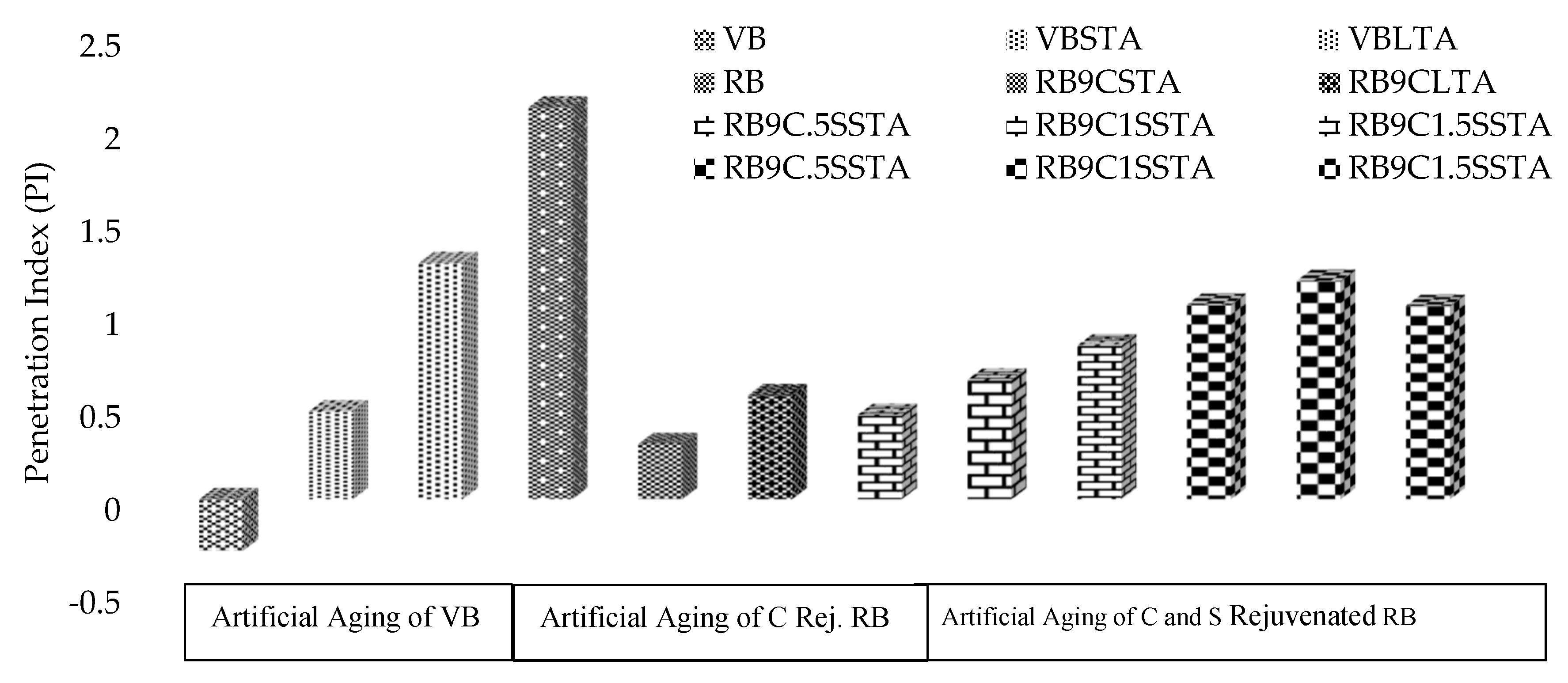
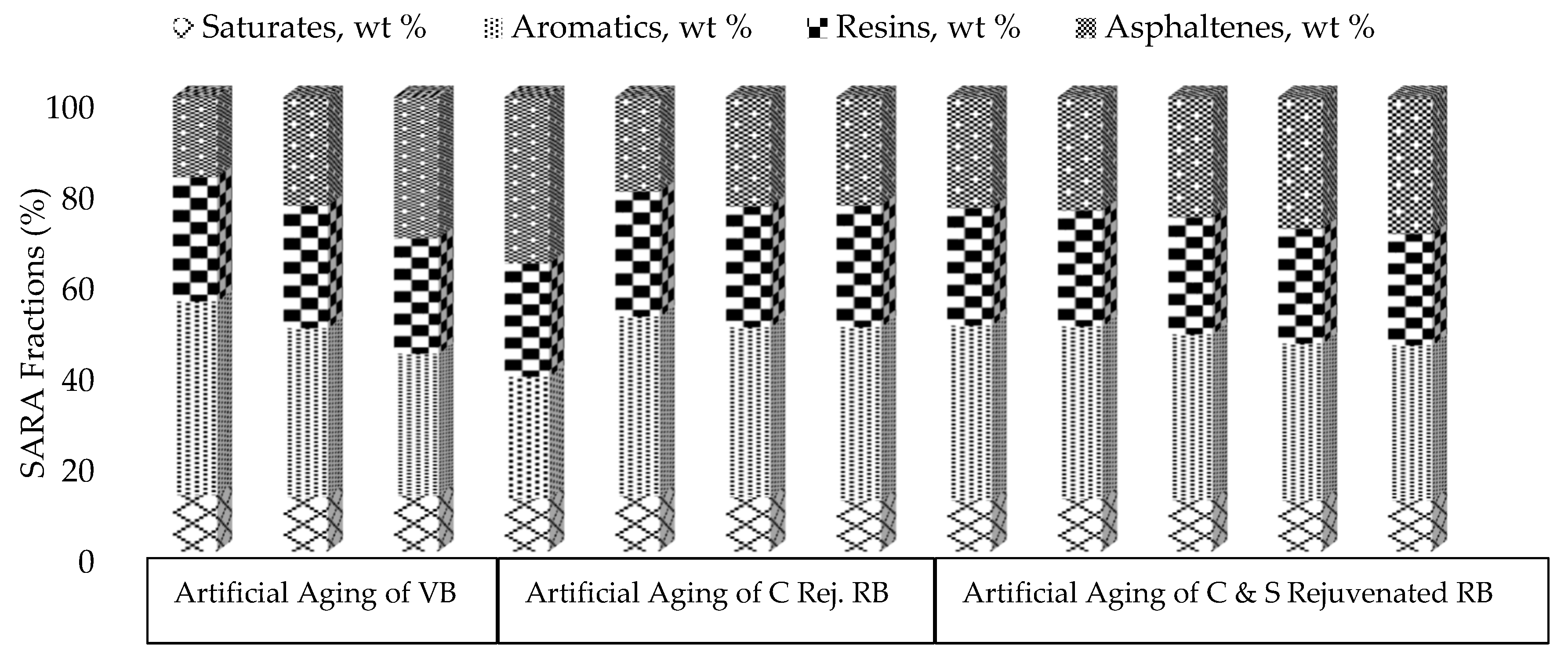
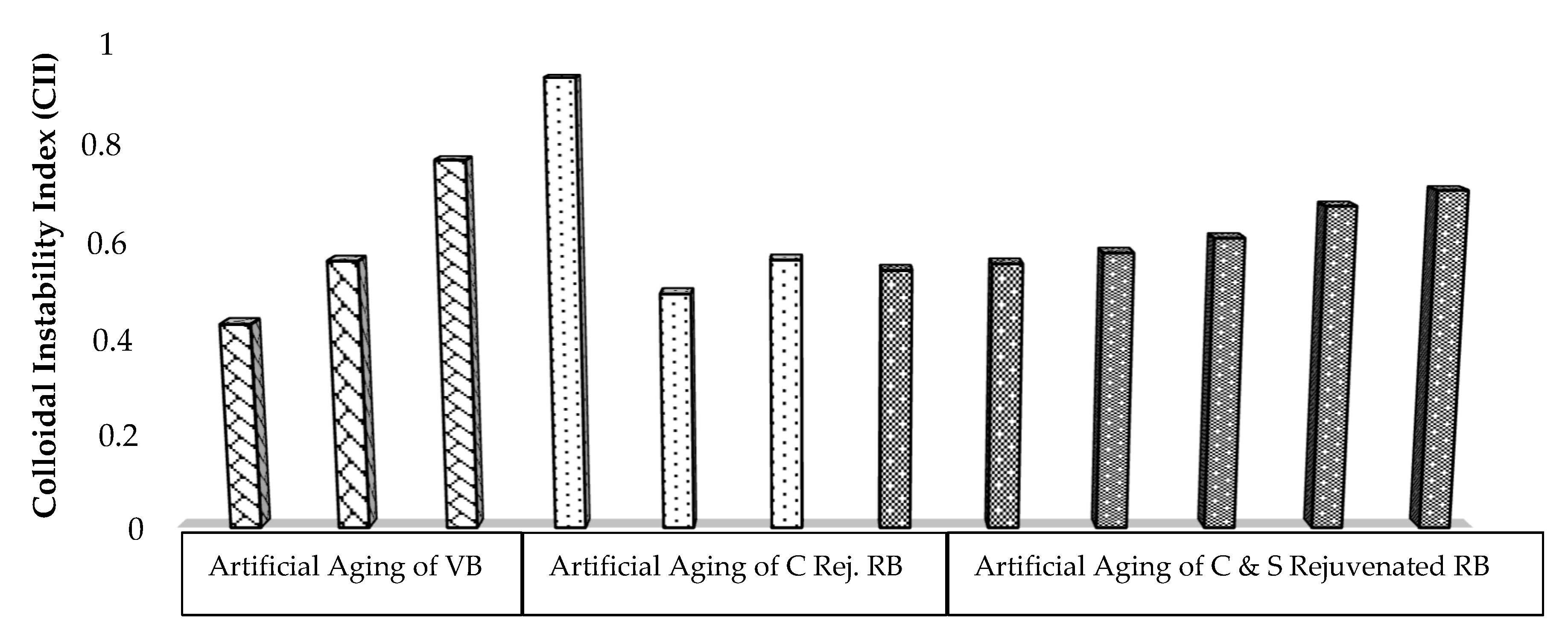

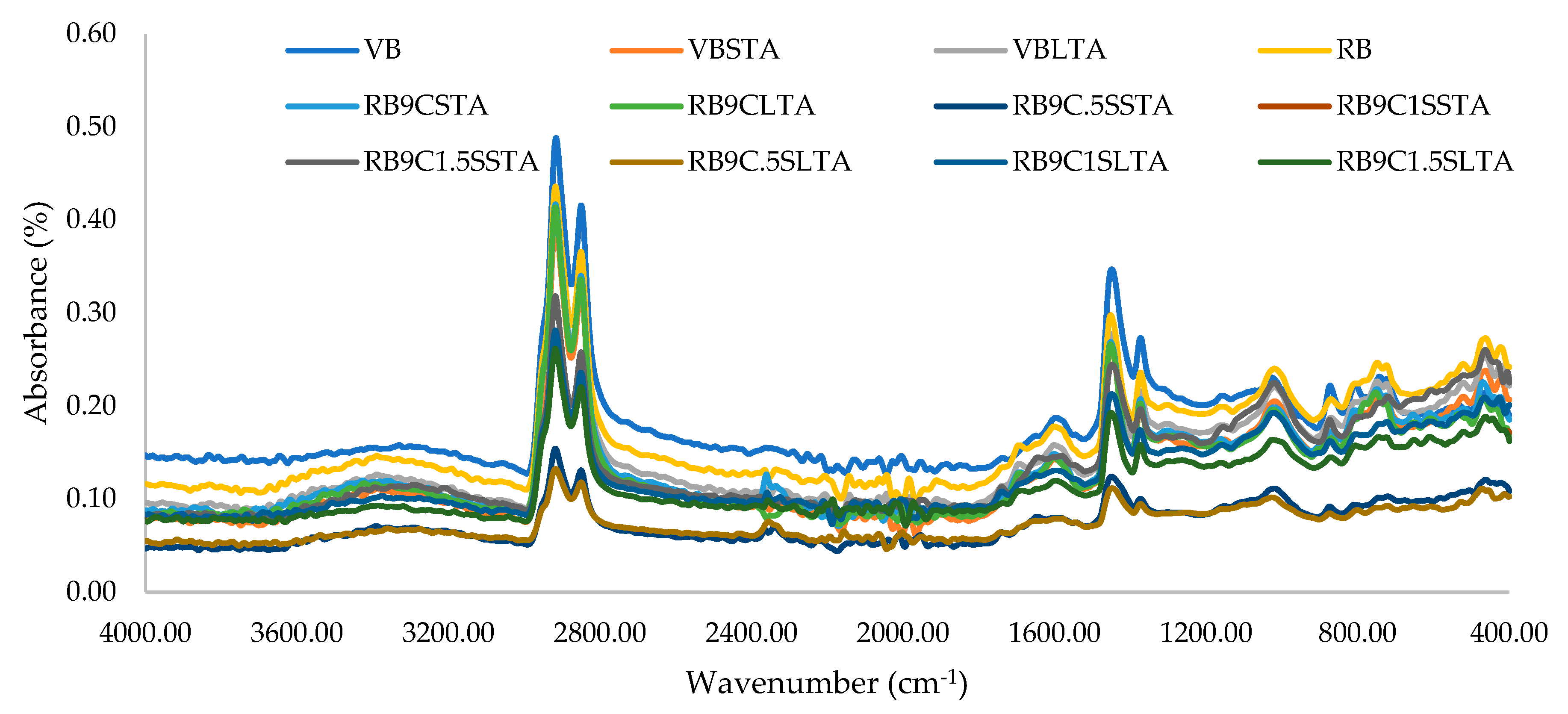
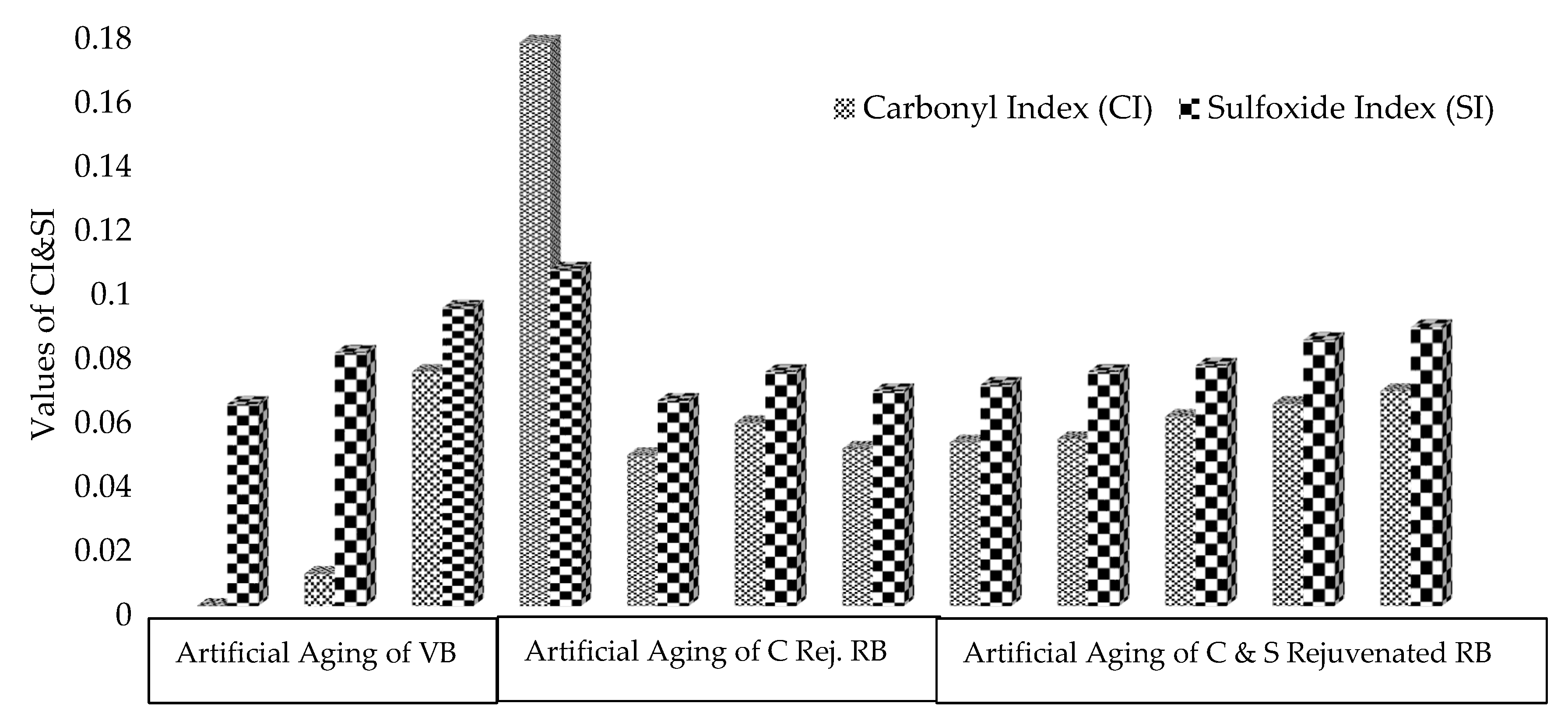



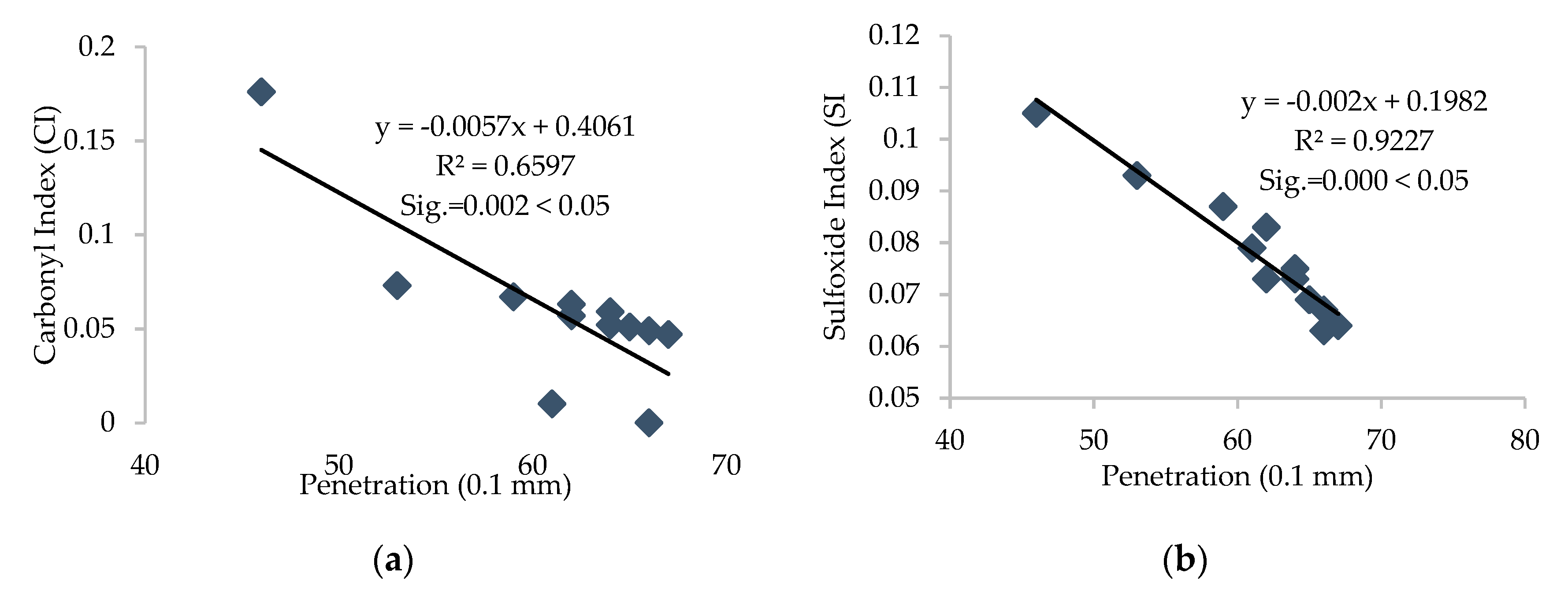

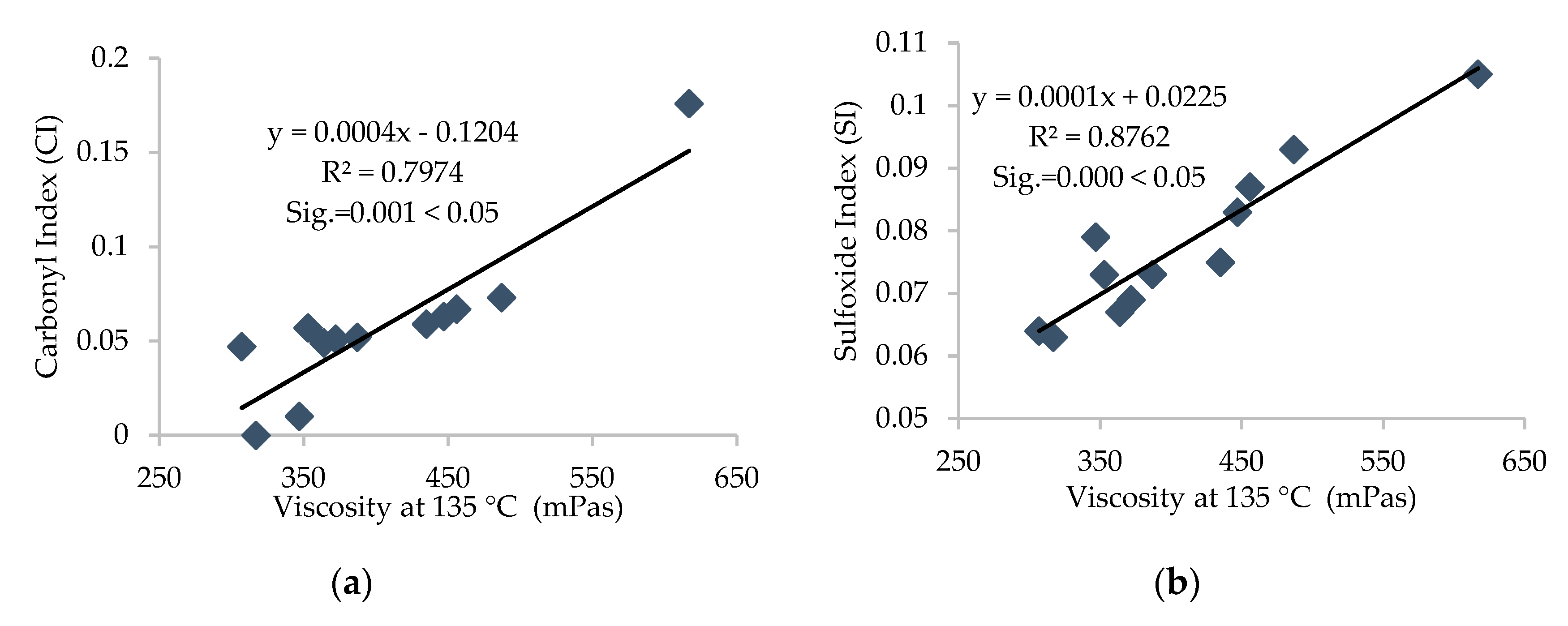

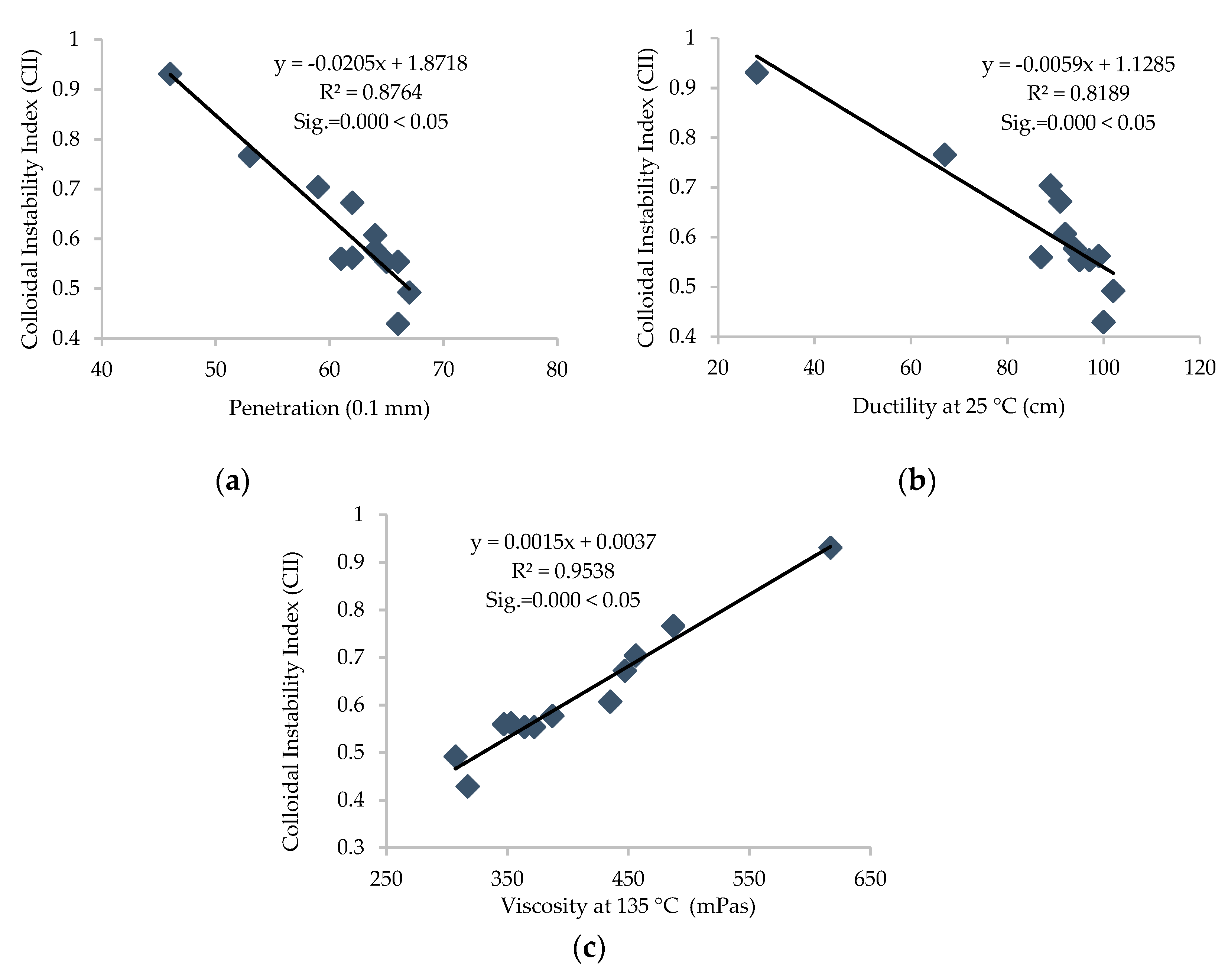
| Property | Virgin Binder | Aged Binder | Cereclor | Sulfur |
|---|---|---|---|---|
| Penetration (0.1 mm) | 66 | 46 | Chlorine Content (%): 70 | − |
| Softening Point (°C) | 51 | 67 | Viscosity at 100 °C (Cp): 86.2 | Melting Point (°C): 115.21 |
| Ductility at 25 °C (cm) | 100 | 28 | Pour Index Approx. (°C): + 20 | Boiling Point (°C): 444.61 |
| Viscosity at 135 °C (mPas) | 317 | 617 | Stability after 4 h 175 °C: 0.2 | Density (g cm−3): 2.07 |
| Sr. No | Binder Matrix | Basic Physical Tests on Asphalt Binder | |||
|---|---|---|---|---|---|
| Penetration Test at 25 °C (AASHTO T49) (dmm) | Softening Point (AASHTO T 53) (°C) | Ductility Test (AASHTO T51) (cm) | Specific Gravity Test @ 25 °C (g/cm3) | ||
| 1 | VB | 66 | 51 | 100 | 1.01 |
| 2 | VBSTA | 61 | 55 | 87 | 1.02 |
| 3 | VBLTA | 51 | 61 | 67 | 1.03 |
| 4 | RB | 46 | 67 | 28 | 1.06 |
| − | RB9C (without aging) | 71 | 50 | 112 | 1.00 |
| 5 | RB9CSTA | 68 | 53 | 102 | 0.99 |
| 6 | RB9CLTA | 63 | 55 | 99 | 0.98 |
| 7 | RB9C0.5SSTA | 66 | 54 | 97 | 1.01 |
| 8 | RB9C1SSTA | 65 | 55 | 95 | 1.012 |
| 9 | RB9C1.5SSTA | 64 | 56 | 94 | 1.014 |
| 10 | RB9C0.5SLTA | 64 | 57 | 92 | 1.013 |
| 11 | RB9C1SLTA | 62 | 58 | 91 | 1.015 |
| 12 | RB9C1.5SLTA | 59 | 58 | 89 | 1.02 |
| CORRELATION | Pen. | SP | Duct. | PI | AC | CII | Vis. | CI | SI | CAI | PG-Upper |
|---|---|---|---|---|---|---|---|---|---|---|---|
| Pen. | 1.00 | −0.87 | 0.96 | −0.84 | −0.88 | −0.94 | −0.89 | −0.81 | −0.96 | −0.88 | −0.71 |
| sp | −0.87 | 1.00 | −0.86 | 0.96 | 0.97 | 0.97 | 0.97 | 0.86 | 0.92 | 0.91 | 0.83 |
| Duct. | 0.95 | −0.86 | 1.00 | −0.83 | −0.83 | −0.91 | −0.89 | 0.85 | −0.89 | −0.90 | −0.74 |
| pi | −0.83 | 0.96 | −0.83 | 1.00 | 0.97 | 0.96 | 0.95 | 0.90 | 0.90 | 0.93 | 0.89 |
| ac | −0.88 | 0.97 | −0.83 | 0.97 | 1.00 | 0.98 | 0.96 | 0.87 | 0.95 | 0.92 | 0.87 |
| cii | −0.93 | 0.97 | −0.90 | 0.96 | 0.98 | 1.00 | 0.97 | 0.89 | 0.97 | 0.94 | 0.85 |
| Vis. | −0.89 | 0.97 | −0.89 | 0.95 | 0.96 | 0.97 | 1.00 | 0.89 | 0.93 | 0.93 | 0.91 |
| ci | −0.81 | 0.87 | −0.85 | 0.90 | 0.87 | 0.89 | 0.89 | 1.00 | 0.79 | 0.99 | 0.90 |
| si | −0.96 | 0.93 | −0.89 | 0.90 | 0.95 | 0.97 | 0.93 | 0.79 | 1.00 | 0.87 | 0.77 |
| cai | −0.88 | 0.91 | −0.90 | 0.93 | 0.92 | 0.94 | 0.93 | 0.99 | 0.87 | 1.00 | 0.91 |
| pg-Upper | −0.71 | 0.84 | −0.74 | 0.89 | 0.87 | 0.85 | 0.91 | 0.90 | 0.77 | 0.91 | 1.00 |
© 2020 by the authors. Licensee MDPI, Basel, Switzerland. This article is an open access article distributed under the terms and conditions of the Creative Commons Attribution (CC BY) license (http://creativecommons.org/licenses/by/4.0/).
Share and Cite
Yaseen, G.; Hafeez, I. Effect of Cereclor as Rejuvenator to Enhance the Aging Resistance of Reclaimed Asphalt Pavement Binder. Materials 2020, 13, 1582. https://doi.org/10.3390/ma13071582
Yaseen G, Hafeez I. Effect of Cereclor as Rejuvenator to Enhance the Aging Resistance of Reclaimed Asphalt Pavement Binder. Materials. 2020; 13(7):1582. https://doi.org/10.3390/ma13071582
Chicago/Turabian StyleYaseen, Ghulam, and Imran Hafeez. 2020. "Effect of Cereclor as Rejuvenator to Enhance the Aging Resistance of Reclaimed Asphalt Pavement Binder" Materials 13, no. 7: 1582. https://doi.org/10.3390/ma13071582
APA StyleYaseen, G., & Hafeez, I. (2020). Effect of Cereclor as Rejuvenator to Enhance the Aging Resistance of Reclaimed Asphalt Pavement Binder. Materials, 13(7), 1582. https://doi.org/10.3390/ma13071582




